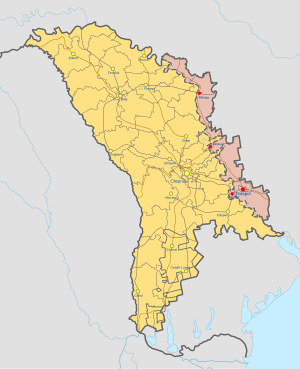
Back Dnestryanı münaqişəsi Azerbaijani Pridnjestrovski sukob BS Transnistrien-Konflikt German Conflicto de Transnistria Spanish درگیری ترانسنیستریا Persian Conflit de Transnistrie French Մերձդնեստրի հակամարտություն Armenian Konflik Transnistria ID Conflito da Transnístria Portuguese Conflictul din Transnistria Romanian
This article has multiple issues. Please help improve it or discuss these issues on the talk page. (Learn how and when to remove these template messages)
|
| Transnistria conflict | |||||||||
|---|---|---|---|---|---|---|---|---|---|
| Part of the post-Soviet conflicts | |||||||||
 Moldova Transnistria | |||||||||
| |||||||||
| Belligerents | |||||||||
 |
|---|
| Constitution |
The Transnistria conflict (Romanian: Conflictul din Transnistria; Russian: Приднестровский конфликт, romanized: Pridnestrovsky konflikt; Ukrainian: Придністровський конфлікт, romanized: Prydnistrovskyi konflikt) is an ongoing frozen conflict between Moldova and the unrecognized state of Transnistria. Its most active phase was the Transnistria War. There have been several attempts to resolve the conflict, although none have been successful.[10][11] The conflict may be considered as having started on 2 September 1990, when Transnistria made a formal sovereignty declaration from Moldova (then part of the Soviet Union).[12]
Transnistria is internationally recognized as a part of Moldova. It has diplomatic recognition only from two Russian separatist states: Abkhazia and South Ossetia.
- ^ Adam, Vlad (2017). Romanian involvement in the Transnistrian War (Thesis). Leiden University. pp. 1–31.
- ^ "Iohannis: Națiunile Unite nu trebuie să tolereze conflictul din Transnistria". Agora (in Romanian). 29 September 2015.
- ^ "Ukraine's stance on Transnistria remains unchanged – Zelensky". Ukrinform. 12 January 2021.
- ^ "Ukraine helps Moldova regain control over border in Transnistrian region". Euromaidan Press. 21 July 2017.
- ^ Ioniță, Tudor (27 April 2022). "VIDEO // Arestovici: Ucraina poate rezolva problema transnistreană "cât ai pocni din degete", dar trebuie ca R. Moldova să-i ceară ajutorul". Deschide.MD (in Romanian).
- ^ O'Reilly, Kieran; Higgins, Noelle (2008). "The role of the Russian Federation in the Pridnestrovian conflict: an international humanitarian law perspective". Irish Studies in International Affairs. 19. Royal Irish Academy: 57–72. doi:10.3318/ISIA.2008.19.57. JSTOR 25469836. S2CID 154866746.
- ^ Munteanu, Anatol (2020). "The hybrid warfare triggered by Russian Federation in the Republic of Moldova". Editura Academiei Oamenilor de Știință din România. 12 (1): 129–162.
- ^ "Russia defends "peacekeepers" the new Moldovan president wants out". Polygraph.info. 7 December 2020.
- ^ Kosienkowski, Marcin; Schreiber, William (8 May 2012). Moldova: Arena of International Influences. Lexington. ISBN 9780739173923. Retrieved 4 September 2022.
- ^ Cojocaru, Natalia (2006). "Nationalism and identity in Transnistria". Innovation: The European Journal of Social Science Research. 19 (3–4): 261–272. doi:10.1080/13511610601029813. S2CID 53474094.
- ^ Roper, Steven D. (2001). "Regionalism in Moldova: the case of Transnistria and Gagauzia". Regional & Federal Studies. 11 (3): 101–122. doi:10.1080/714004699. S2CID 154516934.
- ^ Blakkisrud, Helge; Kolstø, Pål (2013). "From secessionist conflict toward a functioning state: processes of state- and nation-building in Transnistria". Post-Soviet Affairs. 27 (2): 178–210. doi:10.2747/1060-586X.27.2.178. S2CID 143862872.
© MMXXIII Rich X Search. We shall prevail. All rights reserved. Rich X Search